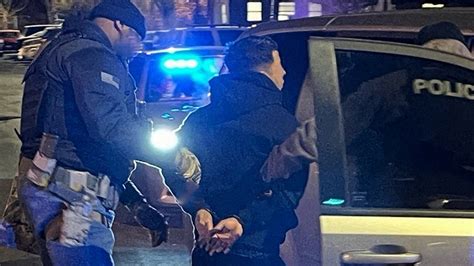
A man attending a court hearing in Norristown, Pennsylvania, was wrongfully detained by Immigration and Customs Enforcement (ICE) agents due to a case of mistaken identity. The man, who remains unnamed in initial reports, was released after authorities confirmed he was not the intended target of the arrest.
A Pennsylvania man was mistakenly apprehended by Immigration and Customs Enforcement (ICE) at the Montgomery County Courthouse in Norristown, sparking outrage and raising serious questions about ICE’s identification and arrest procedures. The incident, which occurred on Tuesday, involved the detention of a man who fit a “general description” of someone ICE was seeking, but was ultimately determined to be the wrong individual. The man was later released once the error was recognized.
“ICE Enforcement and Removal Operations (ERO) officers arrested an individual at the Montgomery County Courthouse in Norristown, Pennsylvania, on June 4, who generally fit the description of an immigration enforcement priority,” an ICE spokesperson stated. “Upon further review, the individual did not match the identity of the enforcement priority, and he was subsequently released.”
The erroneous arrest occurred as the man was present at the courthouse for an unrelated matter. Details regarding the precise nature of the court hearing he was attending have not been released. However, the incident immediately drew condemnation from legal advocates and community members, who expressed concerns about potential civil rights violations and the chilling effect such actions could have on individuals’ willingness to engage with the judicial system.
The American Civil Liberties Union (ACLU) of Pennsylvania swiftly responded to the incident, denouncing the arrest as an example of overreach and a violation of due process. “This is an outrageous example of ICE overreach,” said a representative from the ACLU. “Detaining someone based on a ‘general description’ is a clear violation of due process and raises serious concerns about ICE’s practices.”
The ACLU and other advocacy groups have long criticized ICE’s tactics, particularly those involving arrests at sensitive locations like courthouses, schools, and hospitals. These groups argue that such actions undermine public trust in these institutions and discourage people from accessing essential services or participating in the legal system.
Critics further contend that ICE’s presence in courthouses can deter undocumented immigrants from reporting crimes, appearing as witnesses, or attending court hearings related to family matters, for fear of being detained. This can have far-reaching implications for public safety and the administration of justice.
The mistaken arrest in Norristown has reignited the debate over ICE’s enforcement priorities and the potential for errors in its operations. Advocates are calling for greater transparency and accountability from ICE, as well as clearer guidelines for identifying and apprehending individuals. They also urge policymakers to consider the broader impact of ICE’s actions on immigrant communities and the justice system.
The incident is currently under review to determine the specific circumstances that led to the mistaken arrest and to implement measures to prevent similar errors in the future. The release of the man does not negate the concerns raised about ICE’s procedures and the potential for civil rights violations. The case serves as a stark reminder of the need for vigilance and oversight in immigration enforcement to ensure that individuals are not unjustly detained or targeted based on flawed information or inadequate identification practices.
The fallout from the mistaken arrest continues to unfold, with legal and community organizations demanding answers and assurances that ICE will take steps to prevent such incidents from recurring. The case has also underscored the ongoing tension between immigration enforcement and civil liberties, highlighting the challenges of balancing national security concerns with the protection of individual rights.
Deeper Dive into the Incident:
The event unfolded against a backdrop of increasing scrutiny of ICE’s enforcement activities, particularly in regions with large immigrant populations. Pennsylvania, with its diverse urban and rural communities, has often been a focal point for immigration debates. The Montgomery County Courthouse, located in a densely populated area, serves as a crucial hub for legal proceedings, making the ICE action particularly jarring.
Eyewitness accounts, though limited due to the sensitivity of the situation, suggest that the man was approached by plainclothes ICE agents while he was waiting for his court hearing. The agents reportedly asked him for identification, and despite providing documentation, he was taken into custody.
The “general description” cited by ICE raises significant concerns. Legal experts argue that relying on such vague criteria for an arrest is inherently problematic and can lead to arbitrary detentions based on superficial characteristics. This practice contrasts sharply with the legal standard of “probable cause,” which requires a reasonable belief, supported by facts and circumstances, that a crime has been committed.
Moreover, the incident has highlighted the potential for racial profiling in immigration enforcement. Critics argue that relying on “general descriptions” can disproportionately affect individuals from specific racial or ethnic backgrounds, leading to discriminatory practices.
Impact on the Community:
The mistaken arrest has had a chilling effect on the local immigrant community, with many expressing fear and anxiety about interacting with law enforcement or attending court proceedings. Community leaders report an increase in calls from individuals seeking advice on how to protect themselves from potential ICE encounters.
“People are scared,” said Maria Sanchez, a local community organizer. “They are afraid to go to court, to report crimes, or even to seek medical care because they worry about being detained by ICE.”
This fear can have detrimental consequences for public safety and the well-being of the community. When individuals are afraid to report crimes or seek medical attention, it can lead to increased crime rates, the spread of infectious diseases, and a decline in overall health outcomes.
The incident has also strained relationships between law enforcement and the immigrant community. Building trust between these groups is essential for effective policing and ensuring that everyone feels safe and protected. However, actions like the mistaken arrest can erode that trust and make it more difficult for law enforcement to work effectively.
Legal and Policy Implications:
The mistaken arrest in Norristown raises several important legal and policy questions. One key issue is the extent to which ICE is authorized to make arrests at courthouses. While ICE maintains that it has the authority to conduct enforcement actions in public places, including courthouses, many legal scholars argue that such actions can interfere with the administration of justice and violate the principles of federalism.
Some jurisdictions have enacted policies to limit ICE’s access to courthouses, arguing that these actions undermine the integrity of the judicial system. For example, New York State has implemented rules restricting ICE agents from making arrests inside courthouses without a judicial warrant or exigent circumstances.
The incident also raises questions about ICE’s internal procedures for identifying and apprehending individuals. The agency’s reliance on “general descriptions” suggests a lack of rigor in its identification practices, which can lead to mistaken arrests and civil rights violations.
To prevent future errors, ICE needs to implement more robust identification procedures, including the use of biometric data, such as fingerprints or facial recognition technology. The agency should also provide its agents with better training on how to identify individuals accurately and avoid relying on superficial characteristics.
Furthermore, the incident underscores the need for greater transparency and accountability from ICE. The agency should be required to provide detailed information about its enforcement activities, including the number of arrests made at courthouses, the reasons for those arrests, and the outcomes of the cases. This information would allow the public and policymakers to assess the effectiveness and fairness of ICE’s enforcement practices.
Calls for Reform:
The mistaken arrest in Norristown has added fuel to the ongoing calls for immigration reform. Advocates argue that the incident is a symptom of a broken immigration system that prioritizes enforcement over due process and human rights.
They are calling for comprehensive immigration reform that would provide a pathway to citizenship for undocumented immigrants, strengthen due process protections for immigrants facing deportation, and reduce ICE’s enforcement powers.
Some specific reforms that have been proposed include:
- Ending ICE’s practice of arresting individuals at sensitive locations like courthouses, schools, and hospitals.
- Requiring ICE to obtain a judicial warrant before making an arrest in a private residence.
- Strengthening oversight of ICE’s enforcement activities by Congress and the Department of Homeland Security.
- Providing legal representation to indigent immigrants facing deportation.
These reforms would help to ensure that immigration enforcement is carried out in a fair and humane manner, while also protecting the rights of all individuals, regardless of their immigration status.
The Broader Context of Immigration Enforcement:
The incident in Norristown must be understood within the broader context of immigration enforcement in the United States. For decades, the U.S. has grappled with the challenges of managing its borders, enforcing immigration laws, and integrating immigrants into society.
The current immigration system is characterized by a complex web of laws, regulations, and policies that have evolved over time. The system is often criticized for being overly complex, inefficient, and unfair.
One of the key challenges is the large number of undocumented immigrants living in the U.S. Estimates vary, but it is believed that there are approximately 11 million undocumented immigrants in the country. These individuals come from a variety of countries and have a range of reasons for being in the U.S. Some are seeking economic opportunities, while others are fleeing violence or persecution in their home countries.
The presence of undocumented immigrants has been a source of political debate for many years. Some argue that undocumented immigrants are a drain on public resources and that they take jobs away from American citizens. Others argue that undocumented immigrants contribute to the economy and that they fill essential labor needs.
The debate over immigration has intensified in recent years, particularly with the rise of anti-immigrant sentiment in some quarters. This sentiment has been fueled by concerns about national security, economic competition, and cultural change.
The Trump administration pursued a number of aggressive immigration enforcement policies, including the construction of a wall on the U.S.-Mexico border, the separation of families at the border, and the increased deportation of undocumented immigrants. These policies were widely criticized by human rights groups and immigration advocates.
The Biden administration has taken a more moderate approach to immigration enforcement, but it has also faced challenges in managing the flow of migrants at the border and addressing the root causes of migration.
The incident in Norristown is a reminder of the human cost of immigration enforcement. It highlights the potential for errors and abuses in the system and the need for reforms that protect the rights of all individuals.
Moving Forward:
The mistaken arrest in Norristown should serve as a catalyst for change. It is essential that ICE learns from this error and takes steps to prevent similar incidents from occurring in the future.
More broadly, the incident should prompt a broader conversation about immigration enforcement in the United States. It is time to move beyond the divisive rhetoric and to work towards a more humane and effective immigration system.
This system should be based on the principles of due process, fairness, and respect for human rights. It should prioritize the integration of immigrants into society and should recognize the contributions that immigrants make to the economy and the culture of the United States.
The mistaken arrest in Norristown is a setback, but it is also an opportunity. By learning from this error and working together, we can build a better immigration system for all.
Quote from Yahoo News:
“Upon further review, the individual did not match the identity of the enforcement priority, and he was subsequently released,” according to an ICE spokesperson.
Frequently Asked Questions (FAQ):
1. What exactly happened in the ICE mix-up in Norristown, PA?
An unnamed man was attending a court hearing at the Montgomery County Courthouse in Norristown, Pennsylvania, on Tuesday. ICE agents mistakenly detained him, believing he was someone else they were targeting for immigration enforcement. The man was later released after ICE realized their error, admitting he “did not match the identity of the enforcement priority.” The ACLU of Pennsylvania and other advocacy groups condemned the incident.
2. Why was the man arrested if he wasn’t the intended target?
ICE stated that the man “generally fit the description” of the person they were seeking. Critics argue that relying on such a vague description is problematic and can lead to arbitrary arrests, raising concerns about racial profiling and due process violations. This suggests a lack of precise identification methods by ICE.
3. What has been the reaction to this mistaken arrest?
The reaction has been largely critical. The ACLU of Pennsylvania called it an “outrageous example of ICE overreach” and a “clear violation of due process.” Community leaders and advocacy groups have expressed concerns about the chilling effect such incidents have on immigrant communities, discouraging them from interacting with the legal system or law enforcement.
4. What does this incident say about ICE’s practices and enforcement priorities?
The incident has reignited the debate over ICE’s enforcement priorities and the potential for errors in its operations. It raises questions about ICE’s reliance on “general descriptions” for arrests and the adequacy of their identification procedures. Advocates are calling for greater transparency, accountability, and clearer guidelines for ICE agents. They also urge policymakers to consider the broader impact of ICE’s actions on immigrant communities and the justice system. The incident highlights the ongoing tension between immigration enforcement and civil liberties.
5. What are the potential legal and policy implications of this mistaken arrest?
The incident raises legal questions about the extent to which ICE is authorized to make arrests at courthouses and the validity of arrests based on “general descriptions.” Policy implications include calls for immigration reform, ending ICE’s practice of arresting individuals at sensitive locations, requiring judicial warrants for arrests in private residences, strengthening oversight of ICE’s activities, and providing legal representation to indigent immigrants facing deportation.









